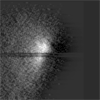Emily Lakdawalla • Sep 11, 2008
An amazing animation of Halley's comet from Vega 1
With so much talk of asteroids and comets lately I thought it'd be a good time to post this amazing artifact from the past. It's actually not from the very distant past, but it's data from the first framing CCD cameras sent into space, aboard the twin Vega spacecraft that flew by Venus and went on to rendezvous with Halley's comet. Enjoy the animation below. You should definitely click to enlarge it to its full size, a 2-MB animated GIF. Sorry for the large file size, but the noisiness of the data makes it difficult to compress. It's worth the wait.

Russian Academy of Sciences / processing by Edwin Strickland
Vega 1 flies by Halley's comet
The two Vega spacecraft were launched in 1984 to swing by Venus and encounter comet 1P/Halley in March, 1986. They were the first interplanetary spacecraft to carry a framing CCD. This animation consists of 62 images captured near Vega 1's closest approach, and required heavy processing by amateur Edwin Strickland to bring out details of the comet nucleus.Working with the data was challenging, he said, but first, a disclaimer: "This discussion is off the top of my head from 5+ year old memories and is NOT authoritative." If anyone reading this has any corrections to the below, I'd appreciate hearing them, and will post them here.
Ed went on: "Unfortunately, the cameras suffered from a variety of severe quality problems that degraded the images. Vega 2 images were mostly over-exposed, except a very few images taken near closest approach. Vega 1 images used an automatic comet-tracking mode that returned a 200 (I think) pixel square sub-image containing the nucleus, with a considerable amount of nucleus wander occurring within that sub-image while the sub-image wandered all over the CCD's full frame. This image segment extraction allowed a higher data rate, but lost easy reference to any absolute location of the sub-image on the full-frame CCD, making decalibration more difficult."
There are lots and lots of artifacts visible in the images, most obviously a double horizontal black line and a general overall noisiness. "The full image contained a horizontal double-band, black in the original frames. This was a feature in the camera that was (as I recall) part of the nucleus tracking system, possibly a reflecting pair of lines on the camera faceplate. Other chip-fixed defects are visible as the gyrations of the spacecraft made the image wander around the full-frame area of the CCD. The camera had a horrendous 'dark current' (black level) offset. Anything darker than the nucleus and the immediate vicinity of the dust jets next to it were below zero before being digitized and were truncated at zero. If full frame images had been returned, most of the images would have been a uniform, flat black. In addition, the camera was significantly out of focus, had significant semi-periodic herringbone-noise (like Mariner 6 and 7's cameras), had a lot of random Gaussian noise, and had salt-and-pepper noise. Superimposed on all that was a horrendous amount of strong horizontal striping noise that crossed the data before digitization. The striping disappears into the zero-level flat-black parts of the image, so image areas beyond the nucleus can't be used to de-stripe the nucleus."
To make the animation, he "imported the images into an industrial image processing software system and applied a proprietary adaptive de-striping program that I developed that simultaneously sharpens the image's finer scale details. (The sharpening on these images is horizontal only, but that's more than compensated for by the severe suppression of the horizontal stripes in these images. The de-striping also mostly removed the double-dark-stripe, except its entirely black center, which is grayed out in the enhancements.) I then registered the images so the brightest portions of the nucleus (or, where clearly visible, the whole nucleus) were centered in the image. The images were exported with a uniform floating contrast stretch which reduced frame-to-frame variations and were assembled into an animated gif."
With all that, it's amazing that there's anything to see in the image. Yet, just look at it: you can clearly see the three-dimensional shape of the nucleus of the comet rotating in and out of view. Vega 1's closest approach to Halley was more than 10 times farther from the nucleus than Rosetta's recent encounter with Steins. Halley's bigger than Steins, but only by a factor of two or three. Tracking the comet and capturing these images was a major achievement, and one we won't get a chance to attempt again until Halley returns to the inner solar system in 2061. I don't remember why, but I don't think I ever looked up to see Halley in 1986. Hopefully I'll live long enough to get another chance.
The Time is Now.
As a Planetary Defender, you’re part of our mission to decrease the risk of Earth being hit by an asteroid or comet.
Donate Today

 Explore Worlds
Explore Worlds Find Life
Find Life Defend Earth
Defend Earth

